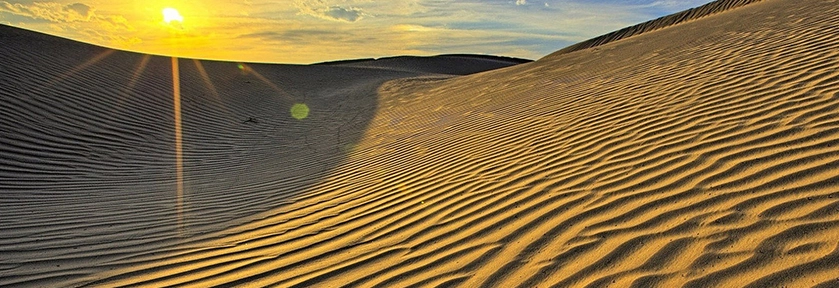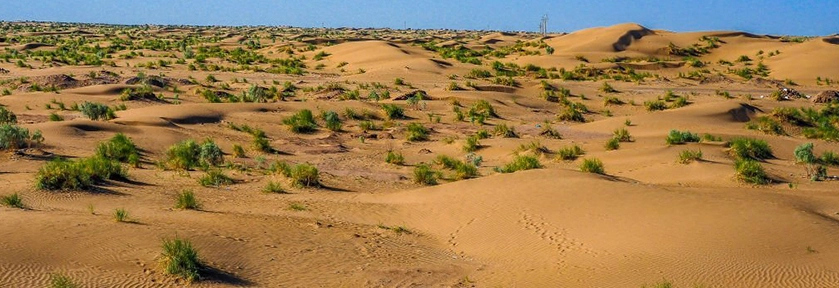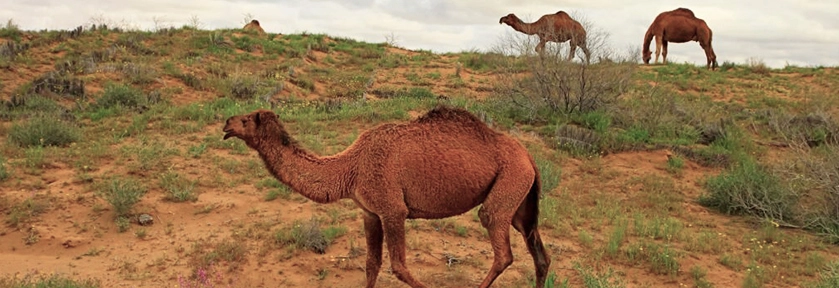The name "Karakum," sometimes written as "Kara-Kum" or locally known as "Garagum," signifies "black sand" in Turkic languages. "Kara" means "dark" or "black," and "kum" means sand. This name honors the shale-rich ink-black sand beneath the desert's surface and is often called "Karakums" in Russian in post-Soviet countries.
Geography and Hydrography of the Karakum
The Karakum Desert occupies vast territories in Turkmenistan and extends into smaller portions of Uzbekistan and Kazakhstan. It covers an area of 350,000 square kilometers, stretching 800 kilometers from west to east and 500 kilometers from north to south.
Yet, what truly distinguishes the Karakum Desert is its hydrography. Groundwater is merely 6-10 meters beneath the surface, making it truly unique. Amidst the vast sand dunes, ancient water reservoirs, called "takyr," are abundant and crucial sources of water for both life and vegetation.
In the northern region of the Karakum Desert, one encounters the remnants of the ancient Uzboy River, an offshoot of the Amu Darya River. In the southern expanse of the desert, the Murgab Tejen rivers breathe life into the arid landscape. These rivers originate from the Hindu Kush mountains in the west, consistently nurturing the desert and upholding its distinct ecosystem.
Climate
The climate in the Karakum Desert is harsh, with scorching summer days and freezing winters. Precipitation is minimal, creating a challenging environment for life. In January, the average temperature drops to -5°C in the north and rises to 3°C in the south. In July, the thermometer climbs to 28°C–34°C. Daily temperature fluctuations are very high, and in some areas, daytime temperatures can exceed 50°C in summer, making this desert one of the hottest places on Earth. The soil itself can heat up to 80°C. Precipitation is scarce, ranging from 60 mm per year in the north to 150 mm in the south, with up to 70% of it occurring from November to April.
Wildlife
Within the Karakum, there is a surprising diversity of wildlife. Various species of animals, including gazelles, jerboas, caracals, and many others, inhabit this area. It also serves as a migration route for birds, making it an attractive location for birdwatching.
In the central parts of the Karakum, you will find unique plants capable of adapting to harsh conditions, such as tamarisk, saxaul, and others. This biodiverse environment plays a crucial role in scientific and ecological research.
Archaeology and Cultural Heritage
The Karakum Desert also boasts a rich archaeological heritage connected to its ancient history. Cave dwellings, remnants of ancient civilizations, and artifacts reveal the history of the Karakum Desert's inhabitants over millennia. One of the most well-known archaeological sites is "Gonur-Depe," an ancient city dating back to 2300 BCE.
Economic Significance
The Karakum Desert plays a vital economic role in the region. The extraction of natural resources like oil and gas is a significant sector of Turkmenistan- economy. The area also supports livestock farming and agriculture, providing a means of livelihood for local residents.
Touristic Potential of the Karakum Desert
The Karakum Desert also offers potential for tourism development. Its unique nature, archaeological findings, and opportunities for outdoor activities attract travelers from around the world. Tourists can embark on hikes through vast dunes, observe wildlife, and explore archaeological sites. The tourism infrastructure, including campsites and tours, is evolving, offering unforgettable experiences.



